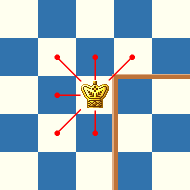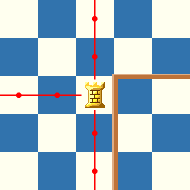_ Puzzle Games _
Maze of Rah

Paso Doble

Just Skidding
Chess Mazes
_ Action Games _
Think Tint
F.A.Q.
Amaze with chess
The object
The goal of each maze is to reach the target square (X) with any of the chess pieces.
How to play (the short version)
Use the mouse to select the piece you'd like to move, then click on the square you want it to move to. A piece can only move when it's protected (under attack) by another piece. There are also two helpful keyboard controls:
- Del or Backspace: undo last move
- Space bar: restart a level
How to play (the whole story)
Chess Mazes presents you with 11 different levels which can be selected from a drop-down list. Each level consists of a few chess pieces laid out inside a maze. You move a piece by selecting it with the mouse, and then selecting the destination square. A level is solved when any of the pieces is brought to the target square.
The main rules for the movement of a piece are:
Besides to these general rules which apply to all pieces, of course the movement of each piece obeys to the rules of chess. For people who don't know chess, here are the rules for the movement of Kings, Knights and Rooks, the only 3 pieces you can encounter in this game.
- A piece can move only if it is protected, i.e. under attack by another piece.
- A piece cannot move on a square already occupied by another piece.
- With the exception of the Knight, a piece cannot move across the walls of the maze.

Kings
Kings can move to any square immediately adjacent. As shown in the figure, they cannot cross walls, but they can round a corner by moving diagonally. Unlike chess, there can be more than one King in a level, and this piece doesn't represent anything special to this game.

Knights
Knights can move from one corner to the other of any 2x3 rectangle of squares, as shown in the figure. The Knight is also the only piece that can jump over other pieces, and over walls.

Rooks
Rooks can move any number of squares horizontally or vertically. Rooks cannot jump over other pieces or walls, as shown in the figure.
Additional notes
Unlike other games of mine, I decided to make solutions publicly available. Just click the "Solution..." button when you are on a level to display the sequence of moves that solves it. A special thank goes to Wolfgang Solfrank, who created a program to solve the levels. By using that program, he found the minimum solutions to some levels, and proved that the other ones can't be optimized any further.
Java applet and level design are copyright © 2001 by Marco Brenco
